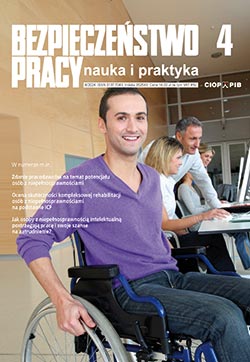Clothing protecting against cold in terms of changes in the requirements of the PN-EN 342 standard
dr inż. MAGDALENA MŁYNARCZYK, dr inż. ANNA DĄBROWSKA
In accordance with the Polish law, employers are expected to provide employees with safe working conditions. In case of the possible exposure of the employees to the harmful influence of the cold environment, the employer has to provide them with properly selected protective clothing against cold, and in this instance “properly” equals meeting the requirements of PN-EN 342:2018-01.
Due to significant changes that were introduced in the new edition of the above-mentioned document, in particular in relation to methodology of testing of thermal insulation with a use of a thermal manikin, the following publication contains information about the differences between the editions of the PN-EN 342 standard from 2006 and 2018. The concepts related to the assessment of the performance of clothing protecting against cold were also explained.
Data sources on the conditions of working environment in Poland
dr inż. ZOFIA PAWŁOWSKA
Information on working environment conditions in Poland is provided mainly by two surveys carried out by the Central Statistical Office, namely the national survey on working conditions and the LFS module survey "Accidents at work and work-related health problems" as well as two international surveys: The European Working Conditions Survey (EWCS), conducted by the European Foundation for the Improvement of Living and Working Conditions (Eurofound), and the European Survey of Enterprises on New and Emerging Risks (ESENER), conducted by the European Agency for Safety and Health at Work (EU-OSHA). The article presents the ways in which information on working environment conditions is collected in these surveys and discusses their information potential in terms of the range of information collected and how it can be used to assess the working environment of workers.
Influence of nanomaterials on human organism
dr LIDIA ZAPÓR
The article presents an analysis of the reasonable new scientific literature findings on the issue of occupational exposure to nanomaterials as well as the results it brings up both towards health and mortality. The issues such as an impact of the exposure to nanomaterials in work environment and its outcome towards selected systems of human organism, such as respiratory, cardiovascular or reproductive systems has been presented. The results of epidemiological studies has been also presented.
Cooperation with robots in the virtual occupational environment. Survey research – practice (2)
dr hab. inż. ANDRZEJ GRABOWSKI, prof. Instytutu
The article presents the results of research on the use of virtual reality to analyze the impact of an industrial collaborative robot on an employee. The results of the statistical analysis of measurements from the conducted research are discussed. The impact of the presence of an industrial robot on objective indicators such as time and precision of the performed tasks of assembling motors as well as subjective indicators such as anxiety and spatial presence describing the realism of simulation in virtual reality was discussed.




























